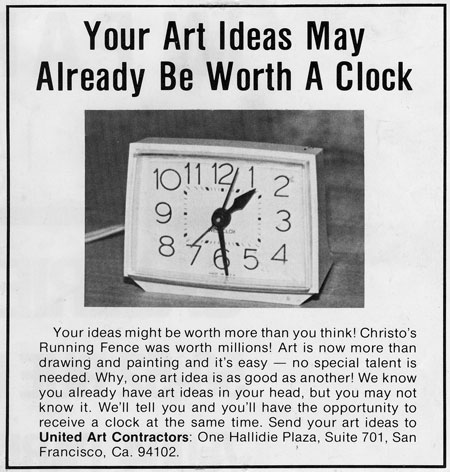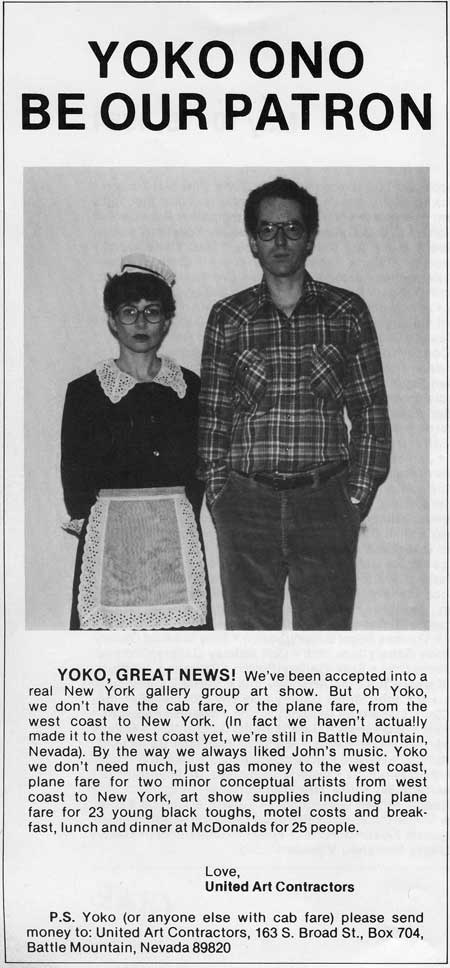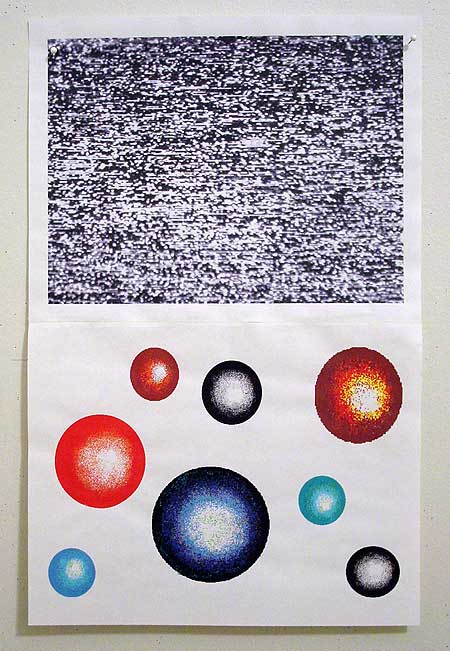
United Art Contractors were among the best artists of the '80s, in this blog's jaundiced opinion. Their self-plugging ads in the back pages of Artforum were a laugh riot, albeit extremely dry. A couple of years of these droll gems brought the artists to the attention of New Museum curator Marcia Tucker, who included "Terri and Dave" (the only names I've ever heard for them) in a group show, netting a blase response from the New York Times ("United Art Contractors' comments on the commercialism of the art world wear thin quickly." - Michael Brenson, 1986).
The images in this post I clipped and saved back in the day and recently scanned--for what it's worth they are the only things I kept from those mid-'80s Artforums. The texts below were found by googling "United Art Contractors."
1. (pdf)
In the mid-1980s, United Art
Contractors, self-described as "minor
conceptual artists," ran a series of ads in
Artforum that humorously tackled
careerism and corruption in the artworld.
"We're Desperate: We Want to Buy Our Way
into a Show" (March 1984) pretty much
sums up their enterprise. The piece
describes “two desperate, middle-aged,
small-town, minor conceptual artists
without time or talent” who want to buy
their way into a large group show. In
September’s "Brilliant New Work by United
Art Contractors," they revealed that they
paid for reviews: “Rave review by well
known art critic $150, medium review by
well known art critic $100, bad review by
well known art critic $50, dynamite review
by average art critic $75, ok review by
average art critic $50, poor review by
average art critic $25; any kind of review
by unknown art critic (it’s all the same
anyway) $10.”
March of 1985 [January, per the
chronology below. --ed] brought
"You Get What You Pay For: No Talents Buy
Their Way In." Michael Selic, president of
Works, San Jose, took the Contractors’
thousand dollars—along with their
stipulation that he spend it entirely on
himself, not the gallery. The show
consisted of “one hour of polite
conversation with wine and cheese (but
only polite conversation, we don’t want
any criticism).”
2. (pdf)
Artforum series:
“Amuse Us.” Artforum 22, no. 5 (January 1984): 92
“We’re Desperate: We Want to Buy Our Way Into a Show.” Artforum 22, no. 7
(March 1984): 112
“Yoko Ono Be Our Patron.” Artforum 22, no. 8 (April 1984): 94
“Your Ideas May Already Be Worth a Clock.” Artforum 22, no. 10 (Summer
1984): 107
“Brilliant New Work by United Art Contractors.” Artforum 23, no. 1
(September 1984): 16
“United Art Contractors Ride Andy Warhol’s Coattails to Success.” Artforum
23, no. 3 (November 1984): 118
“You Get What You Pay For: ‘No Talents Buy Their Way In’.” Artforum 23, no.
5 (January 1985): 31
“Please Tell Us How Pretty We Look.” Artforum 24, no. 1 (September 1985):
46
“We Caused the Shuttle Disaster.” Artforum 25, no. 1 (September 1986): 62
“We Can’t Get our Hair Right,” Artforum 26, no. 3 (November 1987): 179
“Grand Lawyering: A Legacy of Understated Elegance.” Artforum 28, no. 3
(November 1989): 179
“Still Wet Your Pants at Age 40?,” Artforum 28, no. 5 (January 1990): 166


